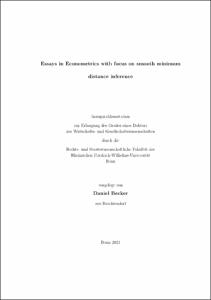Becker, Daniel: Essays in Econometrics with focus on smooth minimum distance inference. - Bonn, 2021. - Dissertation, Rheinische Friedrich-Wilhelms-Universität Bonn.
Online-Ausgabe in bonndoc: https://nbn-resolving.org/urn:nbn:de:hbz:5-63355
Online-Ausgabe in bonndoc: https://nbn-resolving.org/urn:nbn:de:hbz:5-63355
@phdthesis{handle:20.500.11811/9254,
urn: https://nbn-resolving.org/urn:nbn:de:hbz:5-63355,
author = {{Daniel Becker}},
title = {Essays in Econometrics with focus on smooth minimum distance inference},
school = {Rheinische Friedrich-Wilhelms-Universität Bonn},
year = 2021,
month = aug,
note = {This thesis consists of three self-contained essays in econometrics and statistics. It discusses methodological topics in semiparametric statistics as well as dynamic panel data models. In chapters 1 and 2 the smooth minimum distance (SmoothMD) approach is considered in the context of a partially linear model.
The motivation for the SmoothMD estimator is that models nonlinear in parameters that are based on conditional moment restrictions can render inconsistent parameter estimates when the generalized method of moments (GMM) is used for estimation. The reason is that the conditional moment restrictions, that identify the model, imply an infinite number of unconditional moment restrictions if the conditioning variables have a support with infinite cardinality. GMM relies only on a finite number of instruments and, thus, might lead to inconsistent estimates. Therefore, there have recently been proposed several approaches that account for conditional equations at the outset to obtain more efficient estimators. All these approaches share a common feature. The sensitivity to user-chosen parameters, that remains largely unknown. This is one key motivation for the SmoothMD estimator.
In chapter 3 dynamic panel data models with individual fixed effects are considered. The transformed maximum likelihood approach of Hasio et al. is compared to the factor analytical approach proposed by Bai. This is interesting as the first approach considers the model in differences whereas the latter approach focuses on the model in levels. In addition, the factor analytical approach is extended to models with additional exogenous covariates.},
url = {https://hdl.handle.net/20.500.11811/9254}
}
urn: https://nbn-resolving.org/urn:nbn:de:hbz:5-63355,
author = {{Daniel Becker}},
title = {Essays in Econometrics with focus on smooth minimum distance inference},
school = {Rheinische Friedrich-Wilhelms-Universität Bonn},
year = 2021,
month = aug,
note = {This thesis consists of three self-contained essays in econometrics and statistics. It discusses methodological topics in semiparametric statistics as well as dynamic panel data models. In chapters 1 and 2 the smooth minimum distance (SmoothMD) approach is considered in the context of a partially linear model.
The motivation for the SmoothMD estimator is that models nonlinear in parameters that are based on conditional moment restrictions can render inconsistent parameter estimates when the generalized method of moments (GMM) is used for estimation. The reason is that the conditional moment restrictions, that identify the model, imply an infinite number of unconditional moment restrictions if the conditioning variables have a support with infinite cardinality. GMM relies only on a finite number of instruments and, thus, might lead to inconsistent estimates. Therefore, there have recently been proposed several approaches that account for conditional equations at the outset to obtain more efficient estimators. All these approaches share a common feature. The sensitivity to user-chosen parameters, that remains largely unknown. This is one key motivation for the SmoothMD estimator.
In chapter 3 dynamic panel data models with individual fixed effects are considered. The transformed maximum likelihood approach of Hasio et al. is compared to the factor analytical approach proposed by Bai. This is interesting as the first approach considers the model in differences whereas the latter approach focuses on the model in levels. In addition, the factor analytical approach is extended to models with additional exogenous covariates.},
url = {https://hdl.handle.net/20.500.11811/9254}
}






